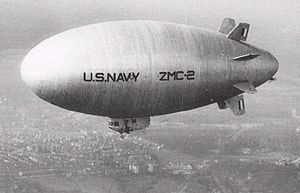ZMC-2
| ZMC-2 | |
|---|---|
 |
|
| Role | Metal-clad airship |
| National origin | United States |
| Manufacturer | Detroit Aircraft Corporation |
| First flight | August 19, 1929 |
| Retired | 1941 |
| Status | Scrapped |
| Primary user | U.S. Navy |
| Produced | 1926–29 |
| Number built | 1 |
| General characteristics (as built) | |
| Displacement: | 200,100 cu ft (5,666.2 m3) |
| Length: | 148 ft 11 in (45.4 m) |
| Beam: | 53 ft 2 in (16.2 m) (hull diameter) |
| Draft: | 64 ft 6 in (19.7 m) (height) |
| Installed power: | 220hp per engine |
| Propulsion: | 2x Wright J-5 Whirlwind 12-cyl. air-cooled radial engines |
| Speed: | 60 knots (110 km/h; 69 mph) |
| Range: | 587 nmi (1,087 km; 676 mi) |
| Complement: | 3 |
| Armament: | None |
The ZMC-2 (Zeppelin Metal Clad 200,000 cubic foot capacity) was the only successfully operated metal-skinned airship ever built. Constructed at Naval Air Station Grosse Ile by The Aircraft Development Corporation of Detroit, the ZMC-2 was operated by the U.S. Navy at Lakehurst, New Jersey from 1929 until its scrapping in 1941. While at Lakehurst it completed 752 flights, and logged 2265 hours of flight time.
The ZMC-2 was built in Grosse Ile, Michigan by the Aircraft Development Corporation, a division of Detroit Aircraft Corporation, on a site shared with, and later acquired by Naval Air Station Grosse Ile. The ZMC-2 was the brainchild of Ralph Hazlett Upson, a balloonist and engineer who had previously won the Gordon Bennett Cup for balloon racing in Europe, bringing the cup to the United States for the first time. Upson teamed up with Carl B. Fritsche of Detroit and together they formed the Detroit Aircraft Corporation, with backing from Henry Ford and Edsel Ford, as well as Charles Kettering of General Motors, Alex Dow, president of Detroit Edison, and William B. Stout, a local industrialist. The airship was constructed in a special hangar built in 1925 for the construction of the ZMC-2, and expandable for the construction of much larger metal-clad airships the company envisioned would be produced later. The hangar measured 120' high, 120' wide and 180' long, and remained the largest structure on the Naval Air Station property until 1960, when it was dismantled and the roof reused in the construction of a bowling alley in nearby Trenton, Michigan.
The ZMC-2 was nicknamed the "Tin Bubble" and was also sometimes called a "tinship". The skin was not tin but Alclad. The airship was roughly teardrop shaped and had eight small stabilizer fins, four of which had rudders. It was held together with over 3.5 million rivets, which were applied by an innovative sewing machine-like device which produced airtight seams.
...
Wikipedia
